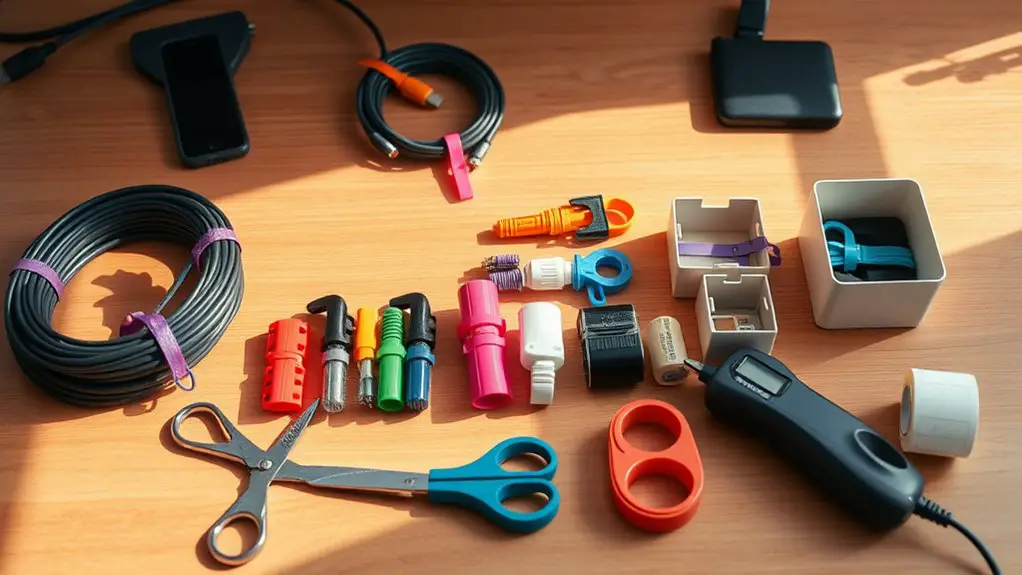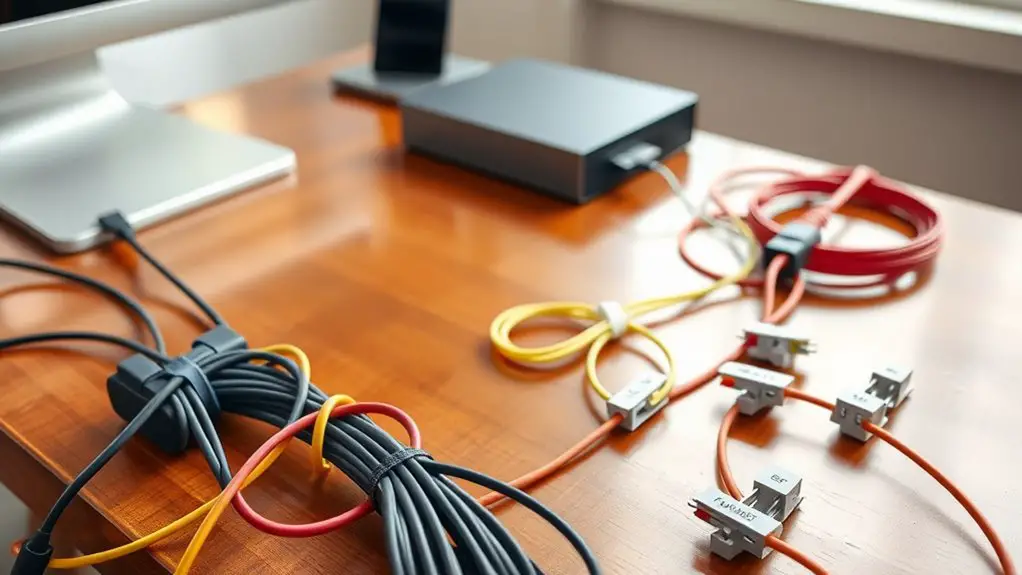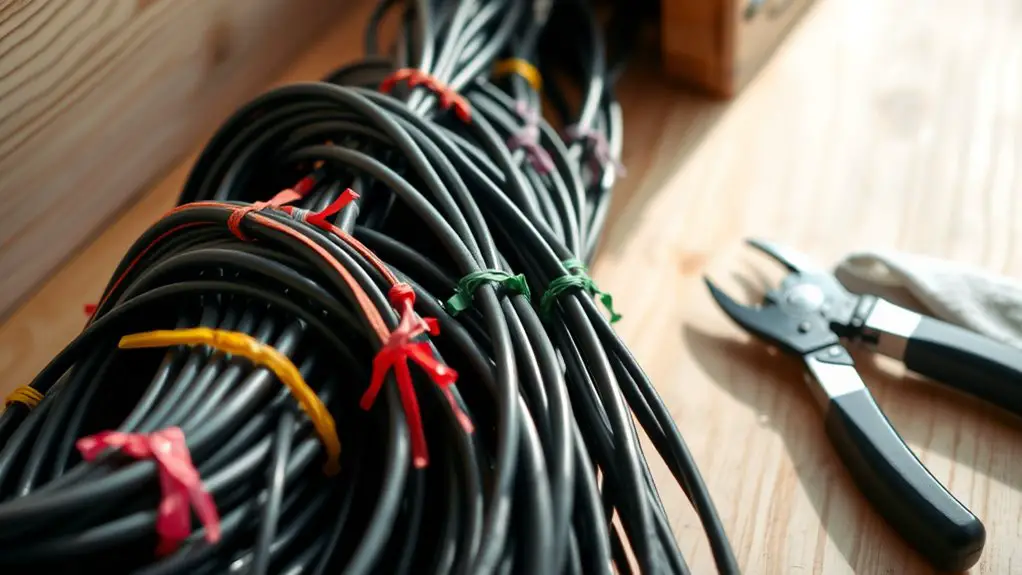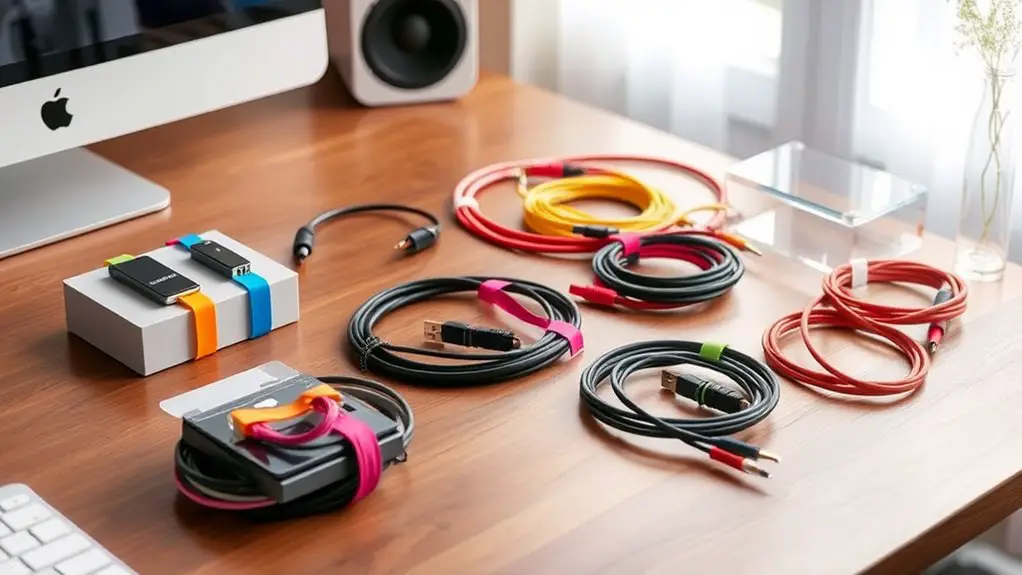To organize cables and wires like a pro, start by using nylon zip ties and adhesive hooks for bundling and routing cables. Invest in cable storage boxes and label each cord for easy identification. Keep your workspace tidy with under-desk trays and wall-mounted channels to conceal wires. Prioritize safety by avoiding wet areas and using protective equipment. With a solid system in place, you'll boost productivity and efficiency. Discover more tips to elevate your cable management game.
Key Takeaways
- Use nylon zip ties to bundle cables together, reducing clutter and improving organization.
- Label each cable with tags or color coding for easy identification and efficient troubleshooting.
- Implement under-desk trays and adhesive hooks to conceal and manage cables discreetly.
- Regularly document and maintain cable connections to ensure accessibility and prevent hazards.
- Utilize cable storage boxes and channels to keep cords organized and integrated with your workspace decor.
Essential Tools for Cable Management

When you're tackling cable organization, having the right tools can make all the difference. Start with nylon zip ties, which are durable and easy to use, perfect for bundling cables together. Consider adhesive hooks to route cables discreetly behind your devices, keeping them out of sight. To achieve a sleek look, use cable looms or channels for organizing cables along walls. Proper cable management not only enhances the aesthetic appeal but also helps prevent safety risks associated with disorganized cables. Floor access grommets let cables pass through safely, while surge protectors help manage power cords efficiently. For workspace management, cable trays and hook-and-loop wraps guarantee your setup remains tidy. Finally, wire organizers like WireMate can simplify managing multiple cables. With these tools, you'll create a clean, organized environment in no time.
Effective Storage Solutions
When it comes to organizing your cables, cable storage boxes are a game changer. They keep everything in one place and make it easy to find what you need. Don't forget to label each cord for quick identification, so you'll never waste time untangling again. Smart cable management simplifies life and creates organized spaces, allowing you to focus on your work without distractions.
Cable Storage Boxes
Cable storage boxes offer an effective solution for managing the chaos of cords and wires in your home or office. They not only keep your space tidy but also enhance safety and productivity. One standout option is a cable management box that features built-in power, eliminating the hassle of using a separate power strip.
Here are some key benefits of using cable storage boxes:
- Convenience and Portability: Easily relocate them as needed.
- Reduced Clutter: Hide unsightly cords for a cleaner look.
- Protection: Some models include surge protection for your devices.
With various types available, from power management boxes to simple containers, you can find the perfect fit for your needs.
Using these boxes can transform your workspace or entertainment area into a more organized and aesthetically pleasing environment, making it easier to focus on what truly matters.
Labeling and Identification
While cable storage boxes help keep your space organized, labeling and identification take your cable management to the next level. Using tags, color coding, and label makers allows you to quickly identify cables, enhancing safety and efficiency. Additionally, proper identification mitigates risks and improves efficiency by preventing incorrect wiring. You can choose from various methods like thermal printing or wrap-around markers for durability.
Here's a quick overview of labeling methods:
| Method | Description |
|---|---|
| Tags and Labels | Easy identification attached post-wiring |
| Color Coding | Indicates purpose via outer jacket colors |
| Wrap-around Markers | Self-laminating for protection |
With the right labels, you'll streamline electrical work, simplify troubleshooting, and guarantee compliance with electrical codes.
Workspace Organization Techniques

To keep your workspace tidy, focus on under-desk cable management and desk attachment solutions. By using tools like cable trays and adhesive hooks, you can effectively route and conceal wires, minimizing clutter. This not only enhances the aesthetic appeal but also boosts your productivity by creating a more organized environment. Implementing systems for organization can further streamline your workspace, ensuring that cables are not only hidden but also easily accessible when needed.
Under-Desk Cable Management
Creating an organized under-desk space not only enhances the aesthetics of your workspace but also improves functionality. Start by unplugging all devices to declutter and sort your cables. Group similar cords together and plan their routes to minimize crossing. One effective way to begin this process is to unplug everything for a fresh start.
Here are a few effective strategies:
- Use cable ties or Velcro straps to bundle excess lengths.
- Label both ends of each cable for quick identification.
- Install under-desk trays or adhesive clips to keep cords neat and secure.
These methods not only keep your workspace tidy but also prevent hazards. By investing a little time in under-desk cable management, you'll create a more efficient and visually appealing environment that's easier to navigate.
Desk Attachment Solutions
Managing cables effectively can transform your workspace into a more organized and efficient environment. Start with cable management kits that provide essential tools like surge protectors and cable mounts. Magnetic cable channels are excellent for routing cords along desk legs, keeping them hidden. Using a wire management kit can significantly enhance your ability to tackle complex cable wrangling, making it easier to maintain order. Use adhesive cable clips to secure cables, preventing them from falling off your desk. Power grommets with USB ports give you easy access to outlets, minimizing clutter. For bundling cables, opt for reusable cable ties or zip ties to prevent tangles. Finally, consider cable sleeves or channels to protect and streamline your cables.
Wall-Mounted Cable Strategies
While cluttered cables can detract from a room's aesthetic, wall-mounted cable strategies offer an effective solution. These methods not only save space but also enhance your home's appearance. Plus, they're generally easy to install and versatile enough to accommodate various cable types. Proper cable management enhances workspace aesthetics and reduces distractions, making these solutions even more beneficial for your home environment.
Here are three popular wall-mounted solutions you might consider:
- Cable Channels: Paintable tubes that conceal cables and blend with your décor.
- Adhesive Hooks: Perfect for routing cables discreetly along walls without damaging surfaces.
- Cable Clamps: Securely hold cables in place, defining their route and reducing visual clutter.
Safety Tips for Cable Maintenance

Maintaining a tidy and organized space with wall-mounted cable strategies is just one part of guaranteeing your cables function safely and efficiently.
Regularly inspect your cables for fraying or burning, and test conductors for continuity after repairs. Verify insulation is intact to prevent moisture intrusion, and keep connectors secure for electrical safety. Conduct insulation resistance tests to ensure the integrity of the insulation layer following repairs.
When working with cables, avoid wet areas and always use appropriate personal protective equipment. Keep a safe distance from overhead power lines and high-voltage equipment.
To prevent physical damage, use protective sleeves and route cables through conduits.
Finally, remember to disconnect power before any repairs, and replace seriously damaged cables instead of attempting repairs. Always treat electrical parts as live until proven otherwise.
Best Practices for Businesses
Organizing cables effectively is essential for any business, as it directly impacts efficiency and safety. To guarantee you manage your cables like a pro, follow these best practices:
- Assess your business requirements to determine current and future infrastructure needs.
- Identify cable paths to optimize airflow and accessibility. Effective cable management solutions can significantly enhance performance by ensuring that cables are organized and well-maintained.
- Plan for scalability so your cable management can grow with your business.
Utilizing tools like cable trays, ties, and management panels can help streamline your setup.
Remember to keep pathways clear, avoid excessive bending, and regularly document your cable types and connections.
Regular maintenance checks will keep your system organized and efficient, ultimately enhancing safety and reducing downtime.
Creative Ways to Label and Identify Cables
When you want to keep your workspace tidy and efficient, labeling and identifying cables is key. Use heat-shrink labels for durability, or opt for non-shrink labels if you need something simpler. Durability is essential for labels exposed to harsh environments or frequent handling, making heat-shrink and non-shrink labels ideal choices. Self-laminating labels protect your text from moisture, while wrap-around labels offer visibility in hard-to-reach spots. Color coding is effective too—tear-resistant tapes and cable flags can quickly help you differentiate cables. For a DIY touch, try binder clips with labels or Ziploc bags to group cords. If you need something portable, consider thermal label printers for on-demand creation. With these creative methods, you'll make your cable organization both efficient and visually appealing!
Frequently Asked Questions
What Are Common Mistakes to Avoid in Cable Management?
When managing cables, avoid common mistakes like ignoring load capacity, neglecting labels, and overcrowding trays. Don't cut insulation or leave cables exposed. Regularly inspect your setup to guarantee safety and efficiency in your workspace.
How Often Should I Check My Cables for Wear?
You should check your cables for wear at least annually, but more frequent inspections in high-stress areas are crucial. Regular visual checks and continuity testing can help guarantee safety and prevent unexpected failures.
Can I Use Household Items for Cable Organization?
Yes, you can definitely use household items for cable organization! Items like binder clips, toilet paper rolls, and shoe boxes can effectively help you manage and store your cables neatly and efficiently. Get creative!
What Are the Environmental Impacts of Cable Waste?
Cable waste harms the environment through long decomposition times, toxic chemical leaching, and pollution. When improperly disposed of, it contaminates ecosystems, threatens wildlife, and contributes to climate change, making responsible management essential.
How Can I Encourage Others to Maintain Cable Organization?
To encourage others in maintaining cable organization, communicate its benefits clearly, involve your team in developing standards, provide training and tools, and recognize their efforts to create a culture of accountability and excellence.
